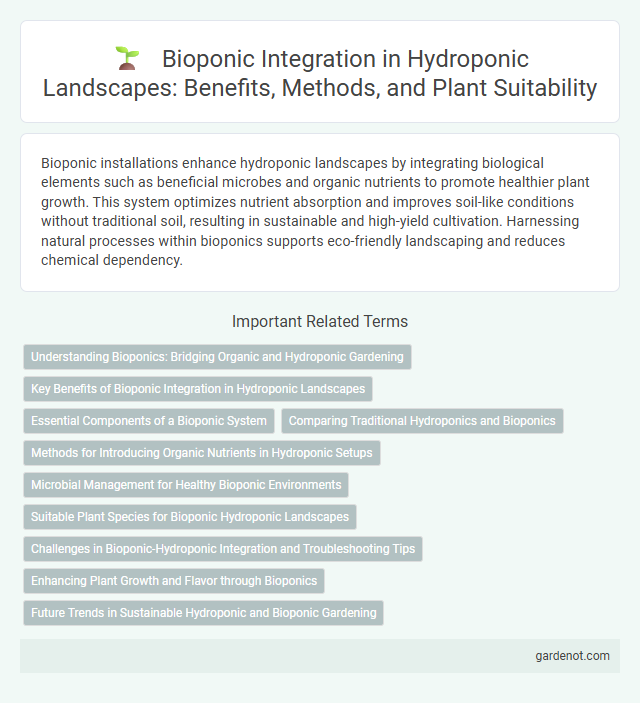Bioponic installations enhance hydroponic landscapes by integrating biological elements such as beneficial microbes and organic nutrients to promote healthier plant growth. This system optimizes nutrient absorption and improves soil-like conditions without traditional soil, resulting in sustainable and high-yield cultivation. Harnessing natural processes within bioponics supports eco-friendly landscaping and reduces chemical dependency.
Understanding Bioponics: Bridging Organic and Hydroponic Gardening
Bioponics integrates the principles of hydroponic systems with organic gardening by utilizing natural microbial inoculants and organic nutrient solutions to nourish plants in a soilless environment. This method enhances plant growth and soil microbial health while maintaining the efficiency and water-saving benefits of hydroponics. Understanding bioponics involves recognizing its role in sustainable agriculture, combining organic nutrient cycling with precision water and nutrient delivery systems commonly found in hydroponic installations.
Key Benefits of Bioponic Integration in Hydroponic Landscapes
Bioponic integration in hydroponic landscapes enhances plant growth by optimizing nutrient delivery through beneficial microorganisms, promoting healthier root systems and higher yield. This method reduces dependency on chemical fertilizers, improving sustainability and reducing environmental impact. Enhanced nutrient absorption and improved soil microbiome balance contribute to resilient plant development and efficient resource use.
Essential Components of a Bioponic System
A bioponic system integrates organic nutrients with hydroponic techniques, requiring key components such as a nutrient reservoir, an aeration system to maintain oxygen levels, and a growing medium like coco coir or perlite to support root structures. Essential to the system is a biofilter or microbial culture that converts organic matter into plant-available nutrients. Efficient water circulation pumps and monitoring sensors regulate pH and nutrient concentration, ensuring optimal growth conditions for hydroponic crops.
Comparing Traditional Hydroponics and Bioponics
Bioponic installation integrates organic nutrients and beneficial microbes into the hydroponic system, enhancing plant growth and nutrient absorption compared to traditional hydroponics, which rely solely on synthetic nutrient solutions. Unlike traditional hydroponics, bioponics improves soil microbiome health, leading to increased resilience against pests and diseases while promoting sustainable crop production. Studies show bioponic systems can boost yield by up to 20% and reduce chemical inputs, making them a more eco-friendly alternative for modern controlled environment agriculture.
Methods for Introducing Organic Nutrients in Hydroponic Setups
Bioponic installation in hydroponic landscapes integrates organic nutrient delivery through methods such as vermicompost tea infusion, biofiltration using beneficial microbial consortia, and liquid organic extracts from composted plant matter. These organic nutrient introduction techniques promote sustainable nutrient cycling, enhance root zone microbial activity, and improve plant health in soil-less cultivation systems. Optimized bioponic setups leverage controlled environment parameters and organic nutrient bioavailability to maximize growth performance and environmental resilience.
Microbial Management for Healthy Bioponic Environments
Effective microbial management in bioponic installations is crucial for maintaining healthy plant growth by optimizing beneficial microbial populations while suppressing pathogens. Utilizing biofilters, microbial inoculants, and continuous monitoring of water quality parameters like pH, EC, and dissolved oxygen enhances nutrient cycling and root health. This approach reduces reliance on chemical treatments, improves disease resistance, and promotes sustainable, high-yield hydroponic landscapes.
Suitable Plant Species for Bioponic Hydroponic Landscapes
Suitable plant species for bioponic hydroponic landscapes include leafy greens such as lettuce, spinach, and kale, which thrive in nutrient-rich, aerated water solutions. Herbs like basil, mint, and cilantro exhibit rapid growth and high yield in bioponic systems due to their preference for consistent moisture and nutrient availability. Fruit-bearing plants such as tomatoes and strawberries adapt well to bioponic installations by benefiting from precise nutrient delivery and root oxygenation, resulting in enhanced flavor and productivity.
Challenges in Bioponic-Hydroponic Integration and Troubleshooting Tips
Bioponic installation in hydroponic landscapes presents challenges such as maintaining balanced nutrient cycles and preventing microbial contamination. Integrating bioponic systems requires precise monitoring of water quality and microbial populations to ensure optimal plant growth. Troubleshooting involves routine checks of pH, dissolved oxygen levels, and beneficial bacteria activity to address issues like nutrient deficiencies and root diseases effectively.
Enhancing Plant Growth and Flavor through Bioponics
Bioponic installation integrates beneficial microbes and nutrient-rich solutions to optimize root absorption, significantly enhancing plant growth and flavor profiles. This method promotes healthier, more vigorous plants by improving nutrient uptake efficiency and stimulating natural plant defenses. Advanced bioponic systems offer precise control over environmental variables, resulting in superior crop yield and intensified taste complexity for hydroponic landscapes.
Future Trends in Sustainable Hydroponic and Bioponic Gardening
Bioponic installation integrates biological nutrients and microorganisms, enhancing plant growth without synthetic chemicals, driving future trends in sustainable hydroponic gardening. Advancements in bioponic systems leverage smart technologies and organic biofertilizers to optimize nutrient delivery and promote eco-friendly urban agriculture. Emerging research emphasizes regenerative approaches, enabling resilient crop production with minimal environmental impact.
Bioponic installation Infographic

 gardenot.com
gardenot.com